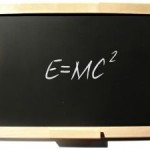At its core a straight razor is a specialized knife. The physics of a straight razor are the same. There are two reasons a knife or scissors cuts: simple pushing force and shear stress. Both are at work when we shave.
Shear stress is at work when you use a scissors to cut through paper. The two blades move past each other forcing the medium being cut to tear. Putting it simply, the hairs can only withstand so much force. A scissors works by holding the hair in place and applying force to shear off the hair being removed. See this page on shearing action for more information and an animation visualizing this concept.
The other physics acting upon our hairs is a simple pushing force. A blade cuts because the edge is extremely small. In the case of a straight razor, .5 microns or smaller. This small edge is then pushed into the hair. The hair, being softer than hardened steel, yields first. The physics is simple: force is magnified if concentrated in a small area. The stress acting upon the hairs is directly proportional to the force being applied and inversely proportional to the surface area. In plainer terms, the hairs will be cut easier if you use more pressure/force and a sharper razor.
So, applying the physics to our shaving regimens, we can have a better understanding of the physics of our shave. The pushing action is generated from the physics of the razor being pushed through the hairs. The hairs, being of a much softer substance, give way easily. But not before the hairs bend and pull. The pushing force is generated by our hands and is directly proportional to our skill level with the straight razor. The shearing action is enacted upon the razor through the skin and the razor blade acting in conjunction with the hair. While not a perfect shearing action, the skin acts as the second force acting upon the hairs. In our case, the skin and hair follicles hold the hair in place while the razor blade slices through the hair.
Check out this time warp clip to see how these forces act upon our faces in slow motion.
As you can see, the razor doesn’t magically cut through the hairs. The razor first meets resistance, the skin is pulled, then when the hairs can stand no more, the razor slices through the hair being cut and moves on to the next hair. This resistance is what causes pulling.

The basic physics law at work is Newton’s second law.
F=MA
In practical terms, the force behind the razor is controlled by how fast and hard we move the razor across our faces. Thus, to achieve maximum cutting force, we should strive to move the blade faster. In reality, the speed of the blade is absolutely restricted by the user’s skill and the threat of cutting into the skin. Put another way: move the razor too fast and your going to look chop up your face.
The other fact we can deduce from this formula is that a heavier razor will cut more effectively than a lighter razor. This is why wedge type razors are perceived to be better than hollow ground razors by some users. This also explains why 8/8″ razors are perceived to cut better. They are also popular the sheer size of the razor is desirable in itself to some users and collectors.
Back to the molecular level. We all know a sharper razor will cut through hairs more efficiently than a dull razor. This is because of the physics of pressure. Concentrating the force into a smaller area increases the level of force acting upon the hairs. The formula is below:
![]()
As you can see, the pressure exerted upon the hair increases as the edge radius decreases. Since reducing the edge radius decreases the surface area in contact with the hair, the force imparted upon the hair is magnified exponentially. However, the razor can only cut as well as the person handling the razor. We can decrease the edge radius to as small as possible, but ultimately, the F component is the key. If the user only uses 50% of their potential, the hair is only being cut half as effectively.
Looking at how razor dulling affects the forces exerted upon the hairs, we have to first define razor dulling. Razor dulling on the molecular level would be an increase in the edge radius (the thickness of the edge where 0 edge radius is a perfect razor). The above formula shows that a 10% increase in edge radius imparts a loss of 9.09% of the pressure acting upon the hairs. A 50% increase in edge radius results in a loss of 1/3 of the pressure. As you can see, the skill of the user is vastly more important than the sharpness of the razor.
So, to sum it all up: The sharper the razor, the greater the impact upon your shaving skill. However, the forces imparted by you are vastly more important than how sharp the razor is.
Did you like this post? Let us know in the comments below.

 According to this new blog post by John Tischler,
According to this new blog post by John Tischler,